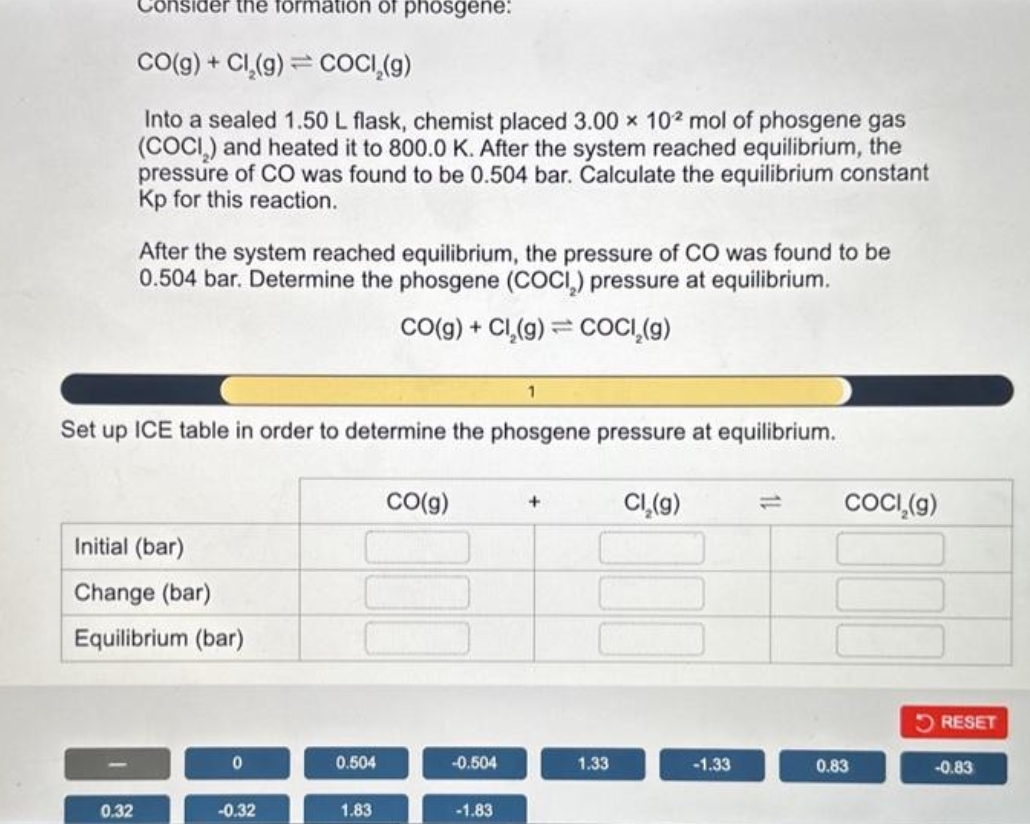CO(g) + Cl₂(g) COCI(g) Into a sealed 1.50 L flask, chemist placed 3.00 x 10² mol of phosgene gas (COCI) and heated it to 800.0 K. After the system reached equilibrium, the pressure of CO was found to be 0.504 bar. Calculate the equilibrium constant Kp for this reaction. After the system reached equilibrium, the pressure of CO was found to be 0.504 bar. Determine the phosgene (COCI,) pressure at equilibrium. CO(g) + Cl₂(g) COCI₂(g) 1
CO(g) + Cl₂(g) COCI(g) Into a sealed 1.50 L flask, chemist placed 3.00 x 10² mol of phosgene gas (COCI) and heated it to 800.0 K. After the system reached equilibrium, the pressure of CO was found to be 0.504 bar. Calculate the equilibrium constant Kp for this reaction. After the system reached equilibrium, the pressure of CO was found to be 0.504 bar. Determine the phosgene (COCI,) pressure at equilibrium. CO(g) + Cl₂(g) COCI₂(g) 1
Chemistry: The Molecular Science
5th Edition
ISBN:9781285199047
Author:John W. Moore, Conrad L. Stanitski
Publisher:John W. Moore, Conrad L. Stanitski
Chapter12: Chemical Equilibrium
Section: Chapter Questions
Problem 61QRT
Related questions
Question
Gg.124.

Transcribed Image Text:Consider the formation of phosgene:
CO(g) + Cl₂(g) COCI₂(g)
Into a sealed 1.50 L flask, chemist placed 3.00 x 10² mol of phosgene gas
(COCI) and heated it to 800.0 K. After the system reached equilibrium, the
pressure of CO was found to be 0.504 bar. Calculate the equilibrium constant
Kp for this reaction.
After the system reached equilibrium, the pressure of CO was found to be
0.504 bar. Determine the phosgene (COCI) pressure at equilibrium.
CO(g) + Cl₂(g) COCI₂(g)
0.32
Set up ICE table in order to determine the phosgene pressure at equilibrium.
Initial (bar)
Change (bar)
Equilibrium (bar)
0
-0.32
0.504
1.83
CO(g)
-0.504
-1.83
n
+
1.33
Cl₂(g)
-1.33
COCI₂(g)
0.83
RESET
-0.83
Expert Solution
This question has been solved!
Explore an expertly crafted, step-by-step solution for a thorough understanding of key concepts.
This is a popular solution!
Trending now
This is a popular solution!
Step by step
Solved in 2 steps with 2 images

Knowledge Booster
Learn more about
Need a deep-dive on the concept behind this application? Look no further. Learn more about this topic, chemistry and related others by exploring similar questions and additional content below.Recommended textbooks for you

Chemistry: The Molecular Science
Chemistry
ISBN:
9781285199047
Author:
John W. Moore, Conrad L. Stanitski
Publisher:
Cengage Learning

General Chemistry - Standalone book (MindTap Cour…
Chemistry
ISBN:
9781305580343
Author:
Steven D. Gammon, Ebbing, Darrell Ebbing, Steven D., Darrell; Gammon, Darrell Ebbing; Steven D. Gammon, Darrell D.; Gammon, Ebbing; Steven D. Gammon; Darrell
Publisher:
Cengage Learning

Introductory Chemistry: A Foundation
Chemistry
ISBN:
9781285199030
Author:
Steven S. Zumdahl, Donald J. DeCoste
Publisher:
Cengage Learning

Chemistry: The Molecular Science
Chemistry
ISBN:
9781285199047
Author:
John W. Moore, Conrad L. Stanitski
Publisher:
Cengage Learning

General Chemistry - Standalone book (MindTap Cour…
Chemistry
ISBN:
9781305580343
Author:
Steven D. Gammon, Ebbing, Darrell Ebbing, Steven D., Darrell; Gammon, Darrell Ebbing; Steven D. Gammon, Darrell D.; Gammon, Ebbing; Steven D. Gammon; Darrell
Publisher:
Cengage Learning

Introductory Chemistry: A Foundation
Chemistry
ISBN:
9781285199030
Author:
Steven S. Zumdahl, Donald J. DeCoste
Publisher:
Cengage Learning

Principles of Modern Chemistry
Chemistry
ISBN:
9781305079113
Author:
David W. Oxtoby, H. Pat Gillis, Laurie J. Butler
Publisher:
Cengage Learning

Introductory Chemistry: A Foundation
Chemistry
ISBN:
9781337399425
Author:
Steven S. Zumdahl, Donald J. DeCoste
Publisher:
Cengage Learning

Chemistry for Engineering Students
Chemistry
ISBN:
9781337398909
Author:
Lawrence S. Brown, Tom Holme
Publisher:
Cengage Learning